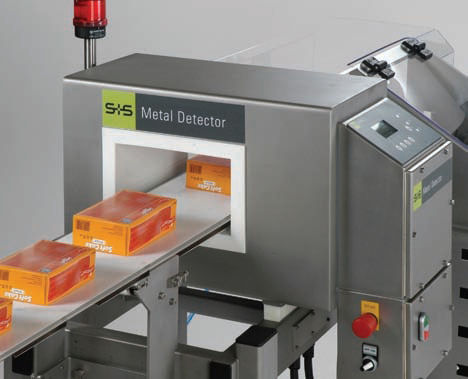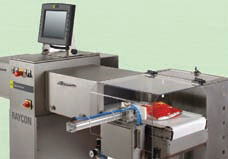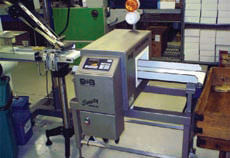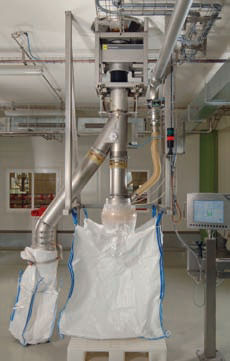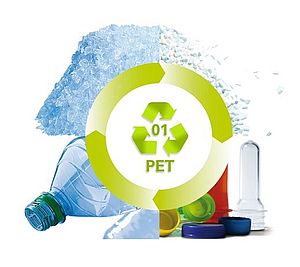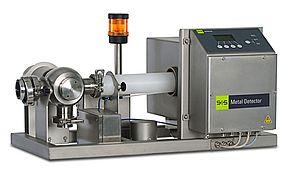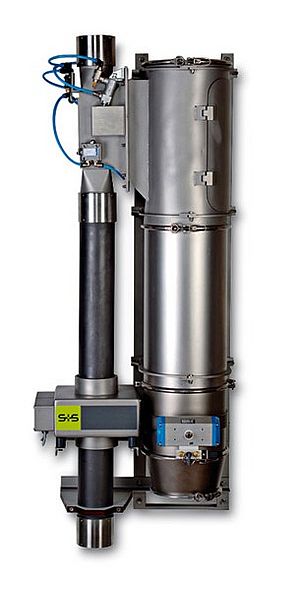On the ‘goods-in’ side they need to protect the company’s investment and on the ‘goods-out’ side to protect the company’s reputation.
The main recent developments in the technology of detecting contamination in food products have been improvements in the sensitivity and ease of operation to minimize the risk of operator error by the use of advanced 2-channel digital signal processors, which provide fully automatic monitoring, calibration and product effect compensation. Current designs are fully compliant with all the relevant quality assurance standards and are equipped with standard data interfaces to enable simple integration into the user’s EDP and production control systems.
The increasing use of metallic containers, especially for ready-meals, requires the use of X-ray systems to reliably detect both metallic and non-metallic contamination to fully meet the consumer protection and stringent hygiene standards (IFS, HACCP). An added benefit of X-ray inspection is the ability to detect flavour clumping and under or overfilled containers simultaneously with foreign body detection.
In parallel with improvements in contamination and product fault detection, the accuracy and reliability of rapid-acting mechanical or pneumatic devices; reject flaps, pneumatic pushers, extraction systems or air blast units has also been improved allowing faster production rates to be achieved.
“Goods-In” Inspection
The wide range of raw materials and ingredients used in the industry, many having been preprocessed by an outside supplier, increases the risk of contamination that may cause damage to process equipment. At this stage, there is a significant risk of both organic and inorganic contamination of the liquid and dry raw materials with metal fragments being the most likely to cause damage to process machinery.
Inspecting for metallic contamination is a welldeveloped technology that has become more effective and flexible with the increased use of digital processing to simplify setting-up and provide data logging for quality assurance recording. Ingredients; chocolate, coffee and milk powder, sugar, flavourings, cereals and nuts, are usually delivered in bulk and distributed to the process machinery, mixing vessels, etc often using gravity or, sometimes, pneumatic or vacuum conveying. Installing metal detection equipment on the delivery pipeline is normally straightforward and ensures that any metallic contamination is detected and removed before it can cause problems in the production area.
Often the problem is one of restricted space availability for the detection equipment and the manufacturers have responded with new detectors that are as small as possible, adaptable and have the control system mounted separately. Typical of this approach is the Rapid series of metal detector/separator system combining high sensitivity with almost infinite adaptability. The two-part design, with the detector unit connected to the reject diverter by quick release fasteners, allows the separation mechanism to be rotated through 180° and the drop height can be adapted to meet all installation requirements. The remotely mounted control system uses 2-channel phase technology combined with digital processing and automatic self-calibration to increase performance reliability and consistency of metal detection, whilst simplifying operation and increasing productivity. The auto-learn capa bility minimizes set-up time and is especially effective when inspecting food products.
Where detection of organic contamination is needed, the only options are manual visual inspection, which is notoriously unreliable and automatic or semi-automatic X-ray inspection. Image recognition software has made fully automatic X-ray contamination detection and separation a practical option where the quality control requirements justify the high cost.
In Process Inspection
Where high value or high volume products are being manufactured, there is a good case for inprocess inspection. The earlier a contaminated product can be detected and rejected, the less production time and materials will be wasted. On many production lines, wide belt detectors are often used where multiple products are conveyed across the belt, usually about 1 metre wide, and use a knife-edge conveyor with a retracting band reject system. Typically, this system is employed in chocolate and biscuit bar production immediately after the enrober, which applies the chocolate coating, prior to wrapping. Wide belts present the metal detector designer with particular problems. Balancing the need to reliably detect small metallic fragments at high speed without rejecting an excessive proportion of uncontaminated product has been made easier by the use of today’s intelligent controllers, incorporating digital signal processing for the detector and precise reject systems.
“Goods Out” Inspection
End-of-line inspection, after wrapping incorporates a number of technologies, although the high conveyor speed demands both sensitivity and reliability. It is essential that every contaminated product is detected and separated, and production speeds of in excess of 300 products per minute means that the metal detectors must be both sensitive and have effective reject control to avoid significant “lost” production. The packaging of individual products using vertical form fill and seal machines fed by a multi head weighing system require a metal detection head, throat detector, to be fitted prior to bagging. To keep drop heights to a minimum and therefore maximize production throughput space is always at a premium. Typically, a detector head is mounted on the delivery tube but no reject device is usually fitted. On detecting a contaminated product, the detector will signal the bagger to produce a double bag, which is easily identified, or the signal may be used to stop the bagger to allow the bag removed manually.
For end of line applications where metallised film is used, the Genius multiple frequency control system will automatically select the appropriate frequency for the product and wrapping material properties and compensate for metallised wrapping and high product effects due to sugar, fats, nuts and other ingredients that may cause other detection systems to be over or under sensitive to contamination. Genius also incorporates an integral HACCP logging capability enabling precise reporting of inspection operations and the necessary functional checks demanded in today’s highly quality conscious production environments. By Richard Lines, Managing Director, S+S Inspection Limited.
Detection & removal of metal contamination in food
The food industry probably faces more inspection problems than most other manufacturing industries.
- by S&S Separation & Sorting GmbH
- April 1, 2009
- 240 views


